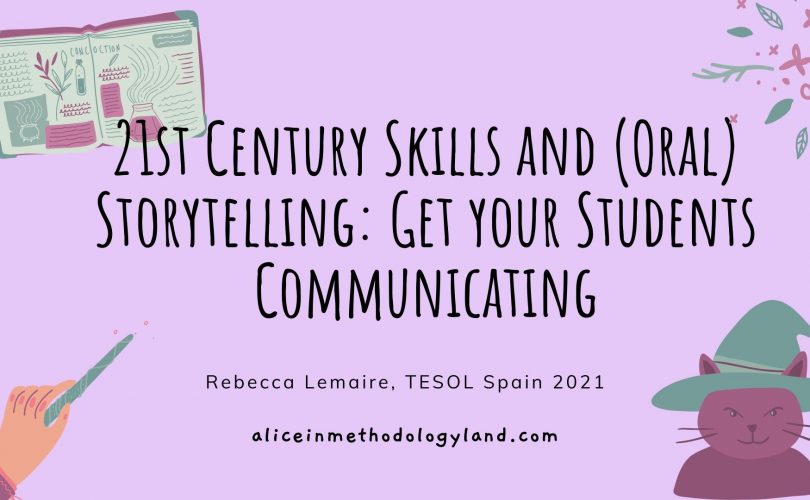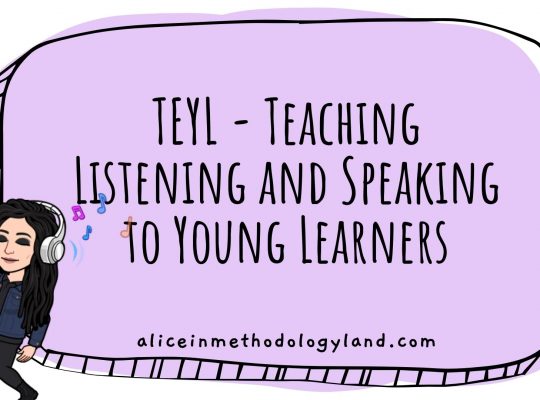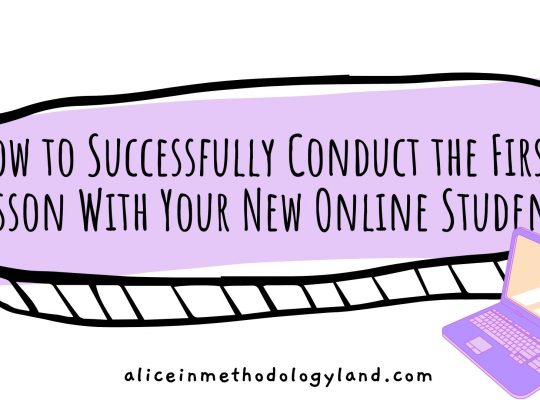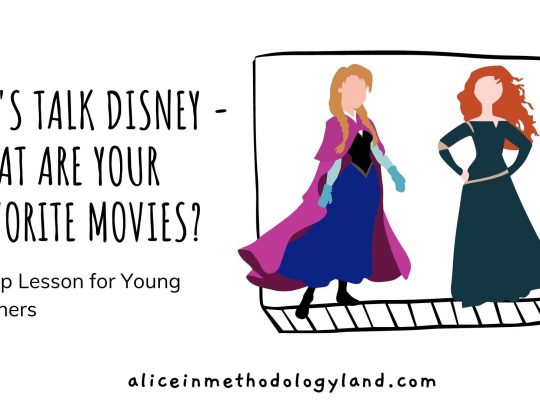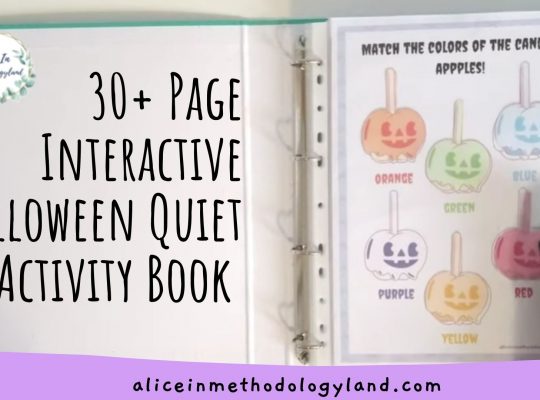Hi, my dear colleagues! This post will be a reflection with a commentary about an excellent presentation from TESOL Spain 2021 titled 21st Century Skills and (Oral) Storytelling: Get your Students Communicating with various speaking activities done by Rebecca Lemaire.
The speaker did not put the word ‘oral’ in the title, but I had to add it since I have many posts about storytelling on my website, and I want to make a distinction.

Abstract
In these times of uncertainty, stories, imagination, and creativity are key for our students to find their way forward. So when planning activities, how can we give our students a voice and move away from competition? Rebecca presents practical and adaptable storytelling activities for all ages, which help our students practice 21st-century skills. So come ready to talk and improvise!
Online storytelling for young learners
I’m sharing this video so that you can see how engaging Rebecca’s sessions are! She seems to be very engaged herself, which is why the learners are also naturally drawn to the storytelling. This is the first tip I always share with teachers: The students see your facial expressions, and they can easily know if you are enjoying what you are doing or not.
Rebecca’s workshop was fully interactive, and the participants were students who were actively participating in many activities listed below.
What 21st century skills can be developed through oral storytelling?
Now, many educators wouldn’t think that storytelling can be used for 21st-century skills. The truth is that every activity you make can be used to promote certain 21st-century skills. Here are some skills that she mentions in her presentation. As you read the activities you can do in the interactive oral storytelling below, try to think which actively promotes a specific skill:
- Collaboration
- Communication
- Creativity
- Critical thinking
- Problem-solving
- Digital literacy
- Citizenship leadership
- Emotional intelligence
- Sense of wonder ✨
Interactive stories
Making an oral story without cutting the flow of the story can be hard, and I have also experienced this in my classroom. Explore these engaging speaking activities that can make your oral storytelling even more magical!
Here are some amazing activities Rebecca recommended for making your story more interactive:
- Repetition, songs, and rhymes as a way of pre-teaching vocabulary for lower-level learners.
- Movement stories.
- What would you do now/and he thought… – This activity includes students’ opinions and elicits speaking naturally. Any volunteer can speak up, finish the sentence and another should continue.
- Quick improvisation in the middle of the story, then continue – this activity can use the sentences from example 3 or be any kind of improvisation.
Activity number 2 is very visual, and it would require you to see how Rebecca leads us through the story to see how she conducts these activities in her sessions. For the movement story, she suggests looking at her video Mr. Wiggle and Mr. Waggle, or Sun and Wind. (If you are interested to see those videos, explore her website – linked below .)
Learning/exploiting the story
These speaking and crafting storytelling activities are usually reserved for something I call post-dramatization on my website (cross-referencing so you can connect the scaffolded steps). Nevertheless, here are some amazing ideas Rebecca suggested, and my additional ideas on how to conduct some of them:
- Sketch a scene/speech bubble + writing – I would suggest making a comic book. You can do literally anything with this activity, it is very versatile.
- Freeze + animate a scene – Doing this live, during the story itself would be amazing. It can be used for description, even grammar (yes, even grammar, since it is so contextual.)
- Interviews (how did a specific character feel in the story) can do wonders for emotional intelligence and they can promote empathy.
- Emotion charts – and activities Rebecca found in the Future Learn course (I cannot remember which one, so I cannot credit it). I would make a bar chart or any kind of chart and cross-reference it to see what some characters have in common, not just emotions.
Stepping outside of the story
Here are some more post-dramatization activities that serve as a way to promote creativity, elicit speaking and promote collaboration. These activities are pretty self-explanatory.
- Create or improvise a dialogue that is not in the story.
- Change an element in the story, such as the setting or the characters.
- Open-ended questions.
The importance of open-ended questions in storytelling with speaking activities
I love open-ended questions because they promote critical thinking skills and allow the students to express themselves and share their creative ideas and opinions.
When it comes to open-ended questions, you must be really careful if you work with young and very young non-native learners – the questions need to be developmentally appropriate and not too complex.
P.S. Open-ended questions are questions that cannot be answered with yes, or no. Therefore, they do not have a correct and a wrong answer, and they require students to express their views without imposing anything on them.
Just as Rebecca mentioned, I rarely use plain comprehension questions. With the youngest ones, I usually ask them to tell which characters they like, why, how the character felt, how they would feel in this situation, etc. However, I add comprehension questions to my digital materials because they are also meant to be used individually with parents at home. Hence, they need all the support they can get.
Goal: students as storytellers and story creators
Logically, the goal of storytelling is almost always to motivate students to be creative. So my goals in storytelling are the same – I want students to express themselves creatively, whether that might be through speaking, drawing, singing, inventing, or dramatizing.
I love to see students’ creations, so I motivate them to draw an alternative ending, make up a story from a specific character’s point of view or improvise their own story from motives from the story they just heard.
Rebecca mentioned one tool (not remember which one, I used it only a few times), but I prefer it for many reasons. Storyjumper allows the students to collaborate, add audio, make a video book, and make sounds as the pages flip. It has many images you can readily use, and people can comment and even PURCHASE a real, printed book if you publish it!
Another tool I use for making interactive books is Genial.ly, which is endless and the best content creation tool out there. You can make literally any digital content that comes to your mind.
To conclude

Rebecca is a great teacher trainer, and of course, an amazing storyteller. I was mesmerized by her energy and her personality. The session inspired me and gave me many new ideas, especially in the dramatization part of her workshop.
The workshop was amazing! I enjoyed it very much because I love storytelling and interactive activities, but there is one point where I’m afraid I have to disagree with the presenter.
I do agree with her that children should always have a voice. But, on the other hand, the activities that include oral storytelling and storytelling with visuals, books, and puppets are equally good. All of them do wonders in creating little readers and build their love towards books.
To conclude, we need to separate the methods and understand many ways to conduct storytelling. None of these methods are wrong, and liking one more is a personal preference. Some of them elicit speech, and some methods enhance reading skills in young learners.
Another point to consider is the fact that so many educators are not very comfortable with acting. In a workshop I conducted about storytelling two weeks ago, we discussed how dramatization is a skill. The participants wanted to know what they can do if they do not have enough courage to dramatize and ‘expose themselves completely‘ as one of them said. So starting with a puppet and gradually including more and more dramatization can be a good idea for shy educators.
Contact Rebecca on her website and explore it to learn more about her oral storytelling methods, activities, and sessions!
Cannot invest in printed books for your classroom? Find thousands of titles online for free!

How do you engage your learners and keep them motivated during storytelling? Have you ever considered using oral storytelling, along with other activities in your lessons? How can we use storytelling to create more speaking activities? Write below or get in touch via the contact page if you have anything to add or say.

Click here to explore our materials corner where 99% of materials are forever free!
All the materials except lesson plans and 30+ page interactive activity books will be free FOREVER! Why? Because sharing is caring, and the past few years have not been kind to any of us. Please consider donating so we can keep making FREE materials for everyone.
Don’t forget to leave a review when you download materials! It’s just a minute of your time, and it means a lot to us.
P.S. The store and the freebie library are not the same things – the freebie library has some extra materials like conference presentations and webinar recordings which are not available in the store
The subscription link for the store is below the author’s bio in every post.
*Our articles may contain affiliate links, which is one of the ways we keep our organization functioning, and we might earn a small commission on links, at no cost to you.
